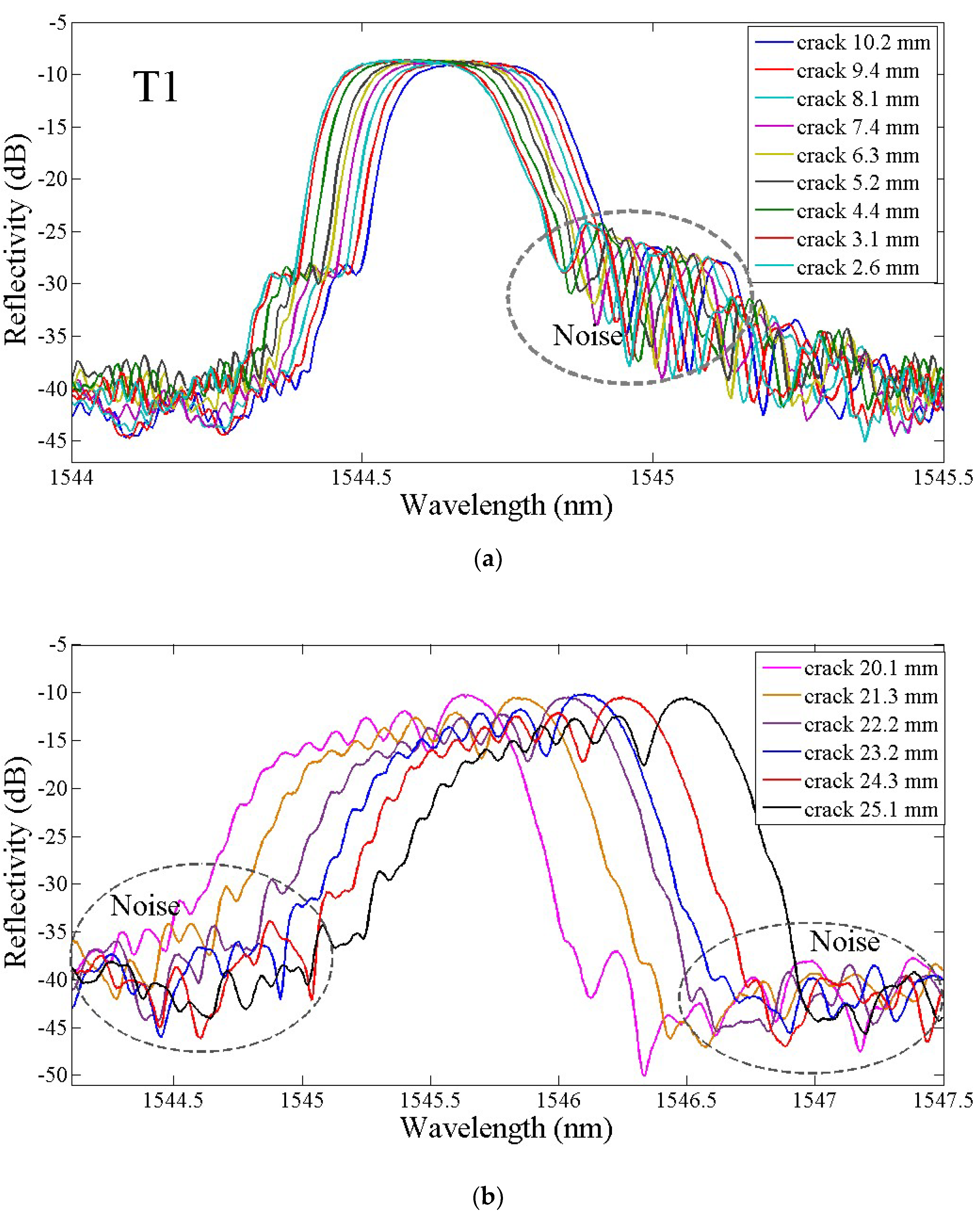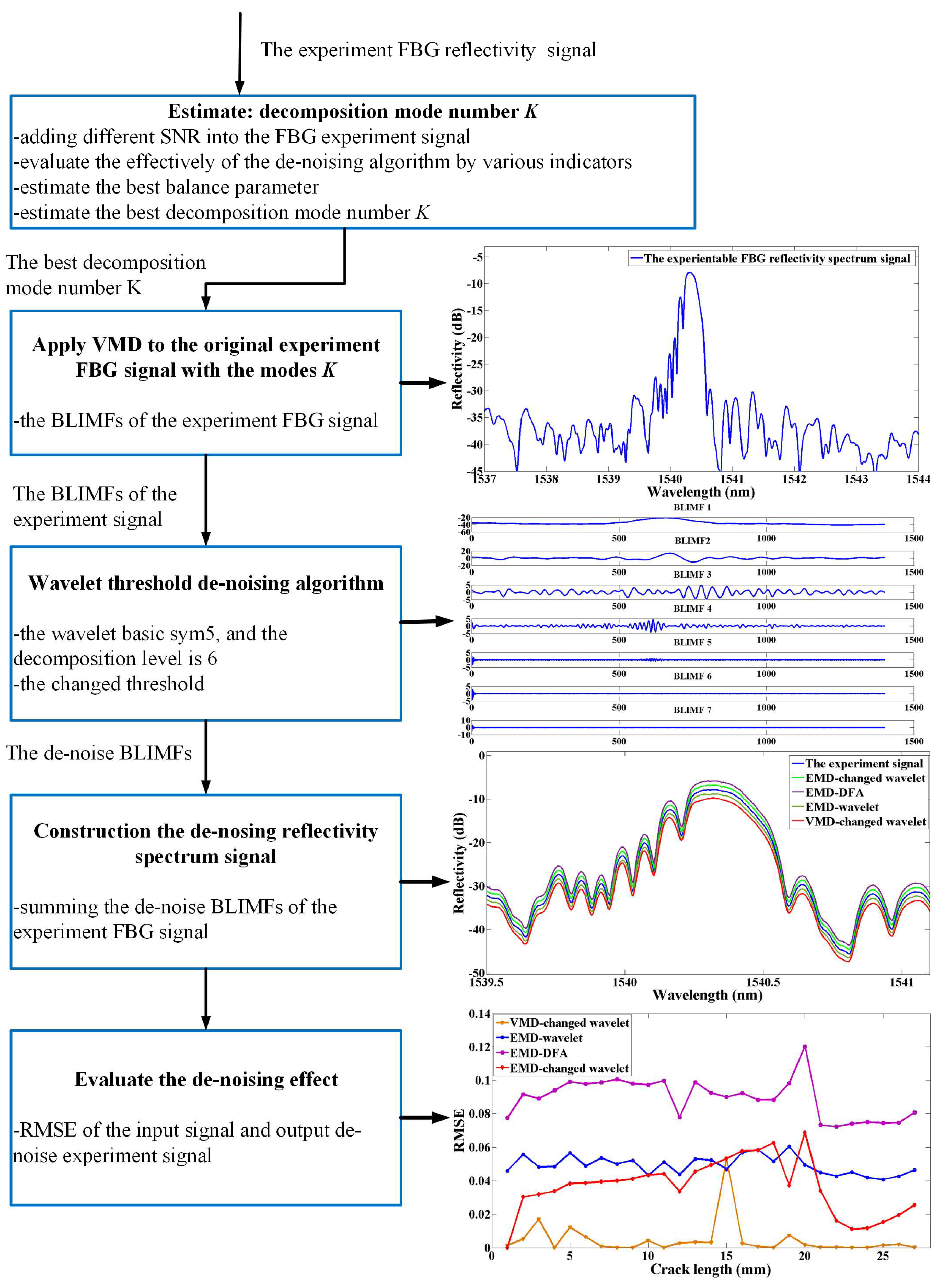Denoising of the Fiber Bragg Grating Deformation Spectrum Signal Using Variational Mode Decomposition Combined with Wavelet Thresholding
Abstract
:Featured Application
Abstract
1. Introduction
2. Experimental Design
2.1. Specimens: Material and Geometry
2.2. Sensor Layout Design
2.3. Experimental Setup
2.4. Experimental Results
3. The Principle of VMD-DWT-Based Denoising
3.1. Brief Description of VMD
3.2. The Improved VMD-DWT Denoising Algorithm
4. Results and Discussion
5. Conclusions
Author Contributions
Funding
Conflicts of Interest
References
- Takeya, H.; Ozaki, T. Structural health monitoring of advanced grid structure using multipoint FBG sensors. In Proceedings of the Smart Structures and Materials 2005: Industrial and Commercial Applications of Smart Structures Technologies, San Diego, CA, USA, 7–10 March 2005; pp. 204–211. [Google Scholar]
- Arsenault, T.J.; Achuthan, A.; Marzocca, P.; Grappasonni, C.; Coppotelli, G. Development of a FBG based distributed strain sensor system for wind turbine structural health monitoring. Smart Mater. Struct. 2013, 22, 075027. [Google Scholar] [CrossRef]
- Jin, B.; Zhang, W. Mechanism of Subordinate Peak Skewing of FBG Sensor during Cracks Propagation Monitoring on Aluminum Alloy Structure. J. Sens. 2017, 2017, 1–7. [Google Scholar] [CrossRef] [Green Version]
- Dragomiretskiy, K.; Zosso, D. Variational Mode Decomposition. IEEE Trans. Signal Process. 2014, 62, 531–544. [Google Scholar] [CrossRef]
- Wang, Y.; Markert, R. Research on variational mode decomposition and its application in detecting rub-impact fault of the rotor system. Mech. Syst. Signal Process. 2015, 60, 243–251. [Google Scholar] [CrossRef]
- Xiaotong, T.U.; Hu, Y. Enhanced Empirical Wavelet Transform with Application to Rolling Bearings Fault Diagnosis. Struct. Health Monit. 2017. [Google Scholar] [CrossRef]
- Li, X.J.; Wang, K. Denoising of the Base Vibration Signal Based on EEMD. Appl. Mech. Mater. 2011, 143, 689–693. [Google Scholar] [CrossRef]
- Huang, N.E.; Shen, Z. The empirical mode decomposition and the Hilbert spectrum for nonlinear and non-stationary time series analysis. Proc. Math. Phys. Eng. Sci. 1998, 454, 903–995. [Google Scholar] [CrossRef]
- Lahmiri, S.; Boukadoum, M. Biomedical image denoising using variational mode decomposition. In Proceedings of the IEEE Biomedical Circuits and Systems Conference (BioCAS) Proceedings, Lausanne, Switzerland, 22–24 October 2014; pp. 340–343. [Google Scholar]
- Sun, Z.G.; Lei, Y. An ECG signal analysis and prediction method combined with VMD and neural network. In Proceedings of the IEEE International Conference on Electronics Information and Emergency Communication, Macau, China, 21–23 July 2017; pp. 199–202. [Google Scholar]
- Zhang, Z.; Li, H. Chatter detection in milling process based on the energy entropy of VMD and WPD. Int. J. Mach. Tools Manuf. 2016, 108, 106–112. [Google Scholar] [CrossRef]
- Jiang, X.; Wang, J. A coarse-to-fine decomposing strategy of VMD for extraction of weak repetitive transients in fault diagnosis of rotating machines. Mech. Syst. Signal Process. 2019, 116, 668–692. [Google Scholar] [CrossRef]
- Liu, Y.; Yang, G. Variational mode decomposition denoising combined the detrended fluctuation analysis. Signal Process. 2016, 125, 349–364. [Google Scholar] [CrossRef]
- Gao, Z.; Wang, X. Online evaluation of metal burn degrees based on acoustic emission and variational mode decomposition. Measurement 2017, 103, 302–310. [Google Scholar] [CrossRef]
- Pasti, L.; Walczak, B. Optimization of signal denoising in discrete wavelet transform. Chemom. Intell. Lab. Syst. 1999, 48, 21–34. [Google Scholar] [CrossRef]
- Lang, M.; Guo, H. Noise reduction using an undecimated discrete wavelet transform. IEEE Signal Process. Lett. 2002, 3, 10–12. [Google Scholar] [CrossRef]
- Chen, Y.; He, M. Processing of FBG sensor signal by improved wavelet. Infrared Laser Eng. 2013, 42, 2784–2789. [Google Scholar]
- Zhi, Z.; Zhu, Y.S. Fault diagnosis of rolling bearings based on EMD Interval-Threshold denoising and maximum likelihood estimation. J. Vib. Shock 2013, 32, 155–159. [Google Scholar]
- Huang, M.; Liu, Y. An Innovation Based DFA and EMD Method for Denoising Fiber Optic Gyroscope Drift Signal. In Proceedings of the International Conference on Information Science and Control Engineering, Beijing, China, 8–10 July 2016; pp. 1262–1266. [Google Scholar]
- Kopsinis, Y.; Mclaughlin, S. Development of EMD-Based Denoising Methods Inspired by Wavelet Thresholding. IEEE Trans. Signal Process. 2009, 57, 1351–1362. [Google Scholar] [CrossRef]
- Gilles, J. Empirical Wavelet Transform. IEEE Trans. Signal Process. 2013, 61, 3999–4010. [Google Scholar] [CrossRef]
- Soman, K.P.; Poornachandran, P.; Athira, S.; Harikumar, K. Recursive Variational Mode Decomposition Algorithm for Real Time Power Signal Decomposition. Procedia Technol. 2015, 21, 540–546. [Google Scholar] [CrossRef] [Green Version]
- Jin, B.; Zhang, W. Investigation on Characteristic Variation of the FBG Spectrum with Crack Propagation in Aluminum Plate Structures. Materials 2017, 10, 588. [Google Scholar] [CrossRef]
- Jiang, H.; Yang, S.U. An Improved Method of Wavelet Threshold De-Noising Applied to FBG Demodulation. Study Opt. Commun. 2016, 2, 40–43. [Google Scholar]
- Jiao, S.; Shi, W. Self-adaptive partial discharge denoising based on variational mode decomposition and wavelet packet transform. In Proceedings of the Chinese Automation Congress, Jinan, China, 20–22 October 2017; pp. 7301–7306. [Google Scholar]
- Liu, S.; Tang, G. Time-Frequency Analysis Based on Improved Variational Mode Decomposition and Teager Energy Operator for Rotor System Fault Diagnosis. Math. Probl. Eng. 2016, 2016, 1–9. [Google Scholar] [CrossRef]
- Kedadouche, M.; Thomas, M. A comparative study between Empirical Wavelet Transforms and Empirical Mode Decomposition Methods: Application to bearing defect diagnosis. Mech. Syst. Signal Process. 2016, 81, 88–107. [Google Scholar] [CrossRef]
- Wang, Y.; Markert, R. Filter bank property of variational mode decomposition and its applications. Signal Process. 2016, 120, 509–521. [Google Scholar] [CrossRef]









| (a) | ||||||||
| SNR (dB) | 5 | 7 | 10 | 15 | 20 | 25 | 30 | 35 |
| EMD-wavelet (soft) | 28.27289 | 29.03794 | 29.94879 | 34.62247 | 36.03779 | 38.70505 | 40.36963 | 40.66328 |
| EMD-DFA | 21.45639 | 20.79891 | 27.80233 | 20.84781 | 37.91600 | 43.04961 | 48.30413 | 53.24952 |
| EMD-DWT | 22.98264 | 24.93801 | 27.80229 | 33.08285 | 37.91601 | 43.04964 | 48.30413 | 53.24952 |
| VMD-DWT | ||||||||
| K = 1 | 18.79288 | 18.65518 | 18.38846 | 18.80969 | 26.82166 | 27.21651 | 32.46437 | 32.66283 |
| K = 2 | 23.01841 | 23.64160 | 19.52073 | 24.16615 | 29.21863 | 32.06180 | 34.01615 | 39.82442 |
| K = 3 | 25.09874 | 25.09611 | 22.54665 | 27.92866 | 30.06698 | 37.79198 | 37.94835 | 44.41590 |
| K = 4 | 28.44365 | 29.81668 | 24.83959 | 29.63455 | 33.04874 | 38.72096 | 39.84002 | 47.23453 |
| K = 5 | 25.99756 | 25.96998 | 29.97101 | 34.78591 | 37.98547 | 43.04964 | 45.16942 | 50.30090 |
| K = 6 | 25.34463 | 25.96834 | 28.86079 | 31.42557 | 35.30840 | 39.04831 | 48.58089 | 53.24953 |
| K = 7 | 24.86184 | 25.77156 | 24.81353 | 31.26708 | 34.64873 | 37.34640 | 32.33718 | 47.70035 |
| K = 8 | 24.32871 | 25.3521 | 24.18736 | 30.30249 | 33.72422 | 37.22826 | 30.94072 | 44.94072 |
| K = 9 | 24.12876 | 24.8201 | 23.26579 | 30.10474 | 32.6836 | 36.1196 | 29.35118 | 41.35118 |
| K = 10 | 24.09218 | 24.5655 | 22.57683 | 29.42232 | 32.57326 | 35.2429 | 28.75985 | 38.75985 |
| (b) | ||||||||
| SNR (dB) | 5 | 7 | 10 | 15 | 20 | 25 | 30 | 35 |
| EMD-wavelet (soft) | 0.999211 | 0.999341 | 0.999463 | 0.999816 | 0.999867 | 0.999928 | 0.999951 | 0.999954 |
| EMD-DFA | 0.996210 | 0.995574 | 0.999120 | 0.995617 | 0.999914 | 0.999974 | 0.999992 | 0.999997 |
| EMD-DWT | 0.997322 | 0.998289 | 0.999120 | 0.999738 | 0.999914 | 0.999974 | 0.999992 | 0.999997 |
| VMD-DWT | ||||||||
| K = 1 | 0.993307 | 0.993061 | 0.999120 | 0.993247 | 0.997264 | 0.996479 | 0.989061 | 0.999711 |
| K = 2 | 0.997981 | 0.997784 | 0.983889 | 0.998011 | 0.998034 | 0.997344 | 0.999127 | 0.999763 |
| K = 3 | 0.998470 | 0.998468 | 0.998160 | 0.997895 | 0.999763 | 0.998193 | 0.999370 | 0.999816 |
| K = 4 | 0.998510 | 0.999638 | 0.998997 | 0.999097 | 0.999880 | 0.999732 | 0.999457 | 0.999899 |
| K = 5 | 0.998343 | 0.999466 | 0.999497 | 0.999897 | 0.999922 | 0.999974 | 0.999594 | 0.999937 |
| K = 6 | 0.998452 | 0.998621 | 0.999261 | 0.999794 | 0.999865 | 0.999819 | 0.999921 | 0.999997 |
| K = 7 | 0.998267 | 0.998529 | 0.998792 | 0.999702 | 0.999719 | 0.999374 | 0.999250 | 0.999891 |
| K = 8 | 0.998037 | 0.998475 | 0.998582 | 0.999699 | 0.999638 | 0.998787 | 0.998633 | 0.999633 |
| K = 9 | 0.997944 | 0.998361 | 0.997440 | 0.999618 | 0.999506 | 0.995454 | 0.998395 | 0.999395 |
| K = 10 | 0.997924 | 0.998315 | 0.997741 | 0.999606 | 0.999426 | 0.992086 | 0.998349 | 0.999349 |
| (c) | ||||||||
| SNR (dB) | 5 | 7 | 10 | 15 | 20 | 25 | 30 | 35 |
| EMD-wavelet (soft) | 0.241370 | 0.213610 | 0.177919 | 0.125300 | 0.083814 | 0.063342 | 0.053885 | 0.052942 |
| EMD-DFA | 0.389650 | 0.364545 | 0.254550 | 0.323424 | 0.079609 | 0.044027 | 0.024160 | 0.013852 |
| EMD-DWT | 0.439771 | 0.354689 | 0.254553 | 0.139824 | 0.079609 | 0.044027 | 0.024160 | 0.013852 |
| VMD-DWT | ||||||||
| K = 1 | 0.640044 | 0.653047 | 0.654553 | 0.633102 | 0.633446 | 0.622933 | 0.620225 | 0.518134 |
| K = 2 | 0.315766 | 0.321990 | 0.448884 | 0.279824 | 0.276412 | 0.317596 | 0.234400 | 0.217975 |
| K = 3 | 0.369700 | 0.296232 | 0.340961 | 0.291351 | 0.186823 | 0.117153 | 0.113686 | 0.114086 |
| K = 4 | 0.296320 | 0.228715 | 0.265572 | 0.172845 | 0.157558 | 0.055798 | 0.073030 | 0.087924 |
| K = 5 | 0.332780 | 0.261142 | 0.17698 | 0.119602 | 0.079603 | 0.044027 | 0.052551 | 0.042896 |
| K = 6 | 0.317743 | 0.297420 | 0.259824 | 0.138284 | 0.103971 | 0.085524 | 0.022050 | 0.013030 |
| K = 7 | 0.349587 | 0.305211 | 0.295239 | 0.142640 | 0.114192 | 0.107896 | 0.094784 | 0.076756 |
| K = 8 | 0.369039 | 0.314728 | 0.339887 | 0.145079 | 0.123990 | 0.119463 | 0.106430 | 0.086430 |
| K = 9 | 0.381169 | 0.318587 | 0.470725 | 0.149699 | 0.137336 | 0.121081 | 0.118543 | 0.078543 |
| K = 10 | 0.384062 | 0.325191 | 0.427981 | 0.156916 | 0.138992 | 0.132615 | 0.129593 | 0.069593 |
© 2019 by the authors. Licensee MDPI, Basel, Switzerland. This article is an open access article distributed under the terms and conditions of the Creative Commons Attribution (CC BY) license (http://creativecommons.org/licenses/by/4.0/).
Share and Cite
Zhang, W.; Zhang, M.; Zhao, Y.; Jin, B.; Dai, W. Denoising of the Fiber Bragg Grating Deformation Spectrum Signal Using Variational Mode Decomposition Combined with Wavelet Thresholding. Appl. Sci. 2019, 9, 180. https://doi.org/10.3390/app9010180
Zhang W, Zhang M, Zhao Y, Jin B, Dai W. Denoising of the Fiber Bragg Grating Deformation Spectrum Signal Using Variational Mode Decomposition Combined with Wavelet Thresholding. Applied Sciences. 2019; 9(1):180. https://doi.org/10.3390/app9010180
Chicago/Turabian StyleZhang, Weifang, Meng Zhang, Yan Zhao, Bo Jin, and Wei Dai. 2019. "Denoising of the Fiber Bragg Grating Deformation Spectrum Signal Using Variational Mode Decomposition Combined with Wavelet Thresholding" Applied Sciences 9, no. 1: 180. https://doi.org/10.3390/app9010180






